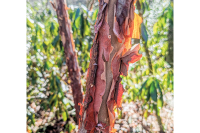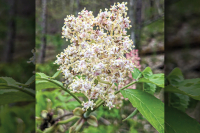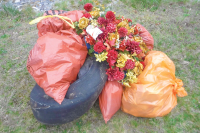Harmon Den bridge will feature animal underpass
 A bear crosses I-40 using a large culvert originally installed with just water in mind, not wildlife. Wildlands Network/National Parks Conservation Association photos
A bear crosses I-40 using a large culvert originally installed with just water in mind, not wildlife. Wildlands Network/National Parks Conservation Association photos
A bridge replacement project underway in the Pigeon River Gorge will temporarily close a section of Interstate 40, but once completed it will make the highway a safer thoroughfare not only for vehicles, but for wildlife as well.
“When the road was built, wildlife weren’t being considered, and now we have these opportunities with the replacement of these structures to consider them,” said Liz Hillard, a wildlife scientist who is one member of the diverse team behind the reimagined bridge.
The bridge now under construction at Harmon Den is one of five the N.C. Department of Transportation has slated for replacement. Georgia-based Kiewit Infrastructure South landed a $19 million contract to replace the first of the five, the bridge at Exit 7 that has been in use since 1965. The closure is scheduled to start Saturday, Nov. 20, and to continue into May, when Kiewit plans to have the new structure in place. Intermittent lane closures will continue through the project’s end in May 2023.
The finished product will feature not only a brand new four-lane bridge, but also a two-lane underpass made specifically for wildlife — the first of its kind in the state.
“We are excited to be adding protections for wildlife in this and other upcoming NCDOT projects,” said Division 14 Engineer Wanda Austin. “We have worked with a wide variety of interest groups, transportation and wildlife experts to incorporate these unique features to benefit the people who drive the gorge, and the animals that live in the gorge.”
Related Items
First of five
The unique bridge plans are largely the result of efforts from a group that first gathered in February 2017 in Asheville. At that time, representatives from a variety of governmental and nonprofit groups came together to discuss the challenges busy roadways like I-40 pose for wildlife populations. That conversation ultimately birthed Safe Passage: The I-40 Pigeon River Gorge Wildlife Crossing Project , a group of two dozen federal, state, tribal and non-governmental organizations dedicated to providing safe ways for wildlife to cross I-40 and other area roadways.
The first step for Safe Passage was to fund research investigating how wildlife interact with the road as-is — Hillard of Wildlands Network and Steve Goodman of the National Parks Conservation Association were chosen to do the work. When they approached the NCDOT for the permits necessary to conduct research along the roadway, Hillard said, the agency began including Safe Passage in discussions about the upcoming bridge replacements, seeking Safe Passage’s input on how the designs could support safe wildlife crossings. As a result, engineers, wildlife biologists and other experts have spent the past three years working collaboratively in search of the best solution for I-40’s bridges.
“The short of it is, the bridge has to be replaced and to add these accommodations, the cost is rather minimal,” said DOT spokesperson David Uchiyama.

An elk uses a vehicle underpass to cross the highway.
While cars drive over Cold Springs Creek, animals will be able to safely pass under the bridge via two purpose-made paths — one on either side of the stream — cutting through the riprap planned for the remainder of the bridge’s underside. A 9-foot-tall fence will guide animals away from traffic and under the bridge, with slotted structures similar to cattle guards discouraging deer and elk from walking up the ramps. While the DOT has built some culvert-style wildlife crossings in the eastern part of the state, this will be the agency’s first experience with this type of the design, Uchiyama said, and the first purpose-made wildlife crossing of any kind in Western North Carolina.
“It’s the guinea pig. It’s the test run, but the plan at least in theory should work well,” said Uchiyama. “For the bridges that get built later on, we’ll take what we learned from this and apply it to those bridges.”
The Harmon Den bridge is just one of five slated for replacement in the Pigeon River Gorge. Contracts for two more bridge projects — one crossing White Oak Road and another that spans both White Oak Road and Jonathan Creek — will be awarded in April, with two more projects on the horizon after that. Wildlife crossings won’t necessarily be in the plans for all five, said Uchiyama, but the DOT will make those decisions based on the need for wildlife accommodations and site suitability in those specific locations.
Freedom to move
Hillard hopes the research she and Goodman did will help make the case for more frequent and comprehensive wildlife crossing designs. The researchers completed the data-gathering phase of the project last year, which included collaring elk, monitoring camera traps and counting roadkill to identify wildlife crossing hotspots and problem areas. They’ve spent 2021 analyzing the data and aim to publish it at the end of the year.
A tally of records from collision reports, DOT maintenance staff in Tennessee and North Carolina, weekly driving surveys from researchers, and the N.C. Wildlife Resources Commission showed 162 large mammals were killed on I-40 in the last four years. Since Jan. 1, 21 deaths have been recorded, of which 13 occurred since Oct. 1. Bear account for the largest share of the roadkill — in the last four years, at least 92 bear, 69 deer and one elk have died on the highway. The figures likely represent an undercount.
“Making sure wildlife are free to move is important, so this Harmon Den opportunity is a big one,” said Hillard. “It is this unique opportunity to increase and provide wildlife habitat connectivity.”
Nearly all of Safe Passage’s 28-mile project area through the gorge traverses undeveloped public land that’s crucial habitat for the region’s wildlife. In Haywood County, the road cuts through the Pisgah National Forest, which becomes the Cherokee National Forest as the road passes into Tennessee. The boundary for the Great Smoky Mountains National Park sits just a short distance west of the highway.
These large swathes of land form vital habitat for diverse species ranging from bears to salamanders, but when those animals need to move from one side of the gorge to the other — whether for food, mating or seasonal migration — they face mortal danger.
“Having a place where wildlife can cross under the interstate safely is a big deal just based on resource availability and things like that,” Hillard said. “Especially when we think about the Southern Appalachians, with the changing climate getting warmer wildlife are going to be moving northward.”
As the effort moves forward, Hillard and her colleagues at Safe Passage hope to see wildlife-oriented infrastructure become the norm rather than the exception, with the dream being to build a large, dedicated wildlife overpass across the gorge. Hillard also wants to see the conversation broaden beyond mammals to consider passageways for aquatic species too. Many of the culverts and other structures in place now don’t let fish and other aquatic organisms move easily from one side to the other.
While the DOT was able to absorb the cost of wildlife crossing accommodations into its existing budget for the Harmon Den project, that won’t always be the case. Additional funding sources could be necessary for future projects. To that end, Safe Passage is collecting donations to support its efforts — but an even bigger boost could come from the federal infrastructure bill President Joe Biden signed Nov. 15. The $1.2 trillion bill includes $350 million in grants for a wildlife crossings pilot program .
“We look forward to working with all the groups, whether they’re nongovernmental or advocacy groups,” said Uchiyama. “From what we’ve seen so far the collaboration has been phenomenal.”
Learn more
Read up on the Safe Passage project or donate at smokiessafepassage.org.
Delays coming to I-40
Starting Saturday, Nov. 20, I-40 will dwindle down to one lane in each direction as it approaches Exit 7 for Harmon Den, with all traffic forced to exit and detour around the bridge using the highway’s on and off ramps.
The detour will allow contractor Kiewit Infrastructure to remove the deteriorating bridge and replace it with a new structure and is expected to remain in effect well into May of next year. After the road reopens, slow-downs and lane closures should be expected until the project’s final completion date of May 2023.
To bypass the roadwork, travelers coming from Asheville can take I-26 West to Kingsport and then I-81 South to Dandridge. The NCDOT urges drivers to ignore directions from travel apps instructing them to bypass the roadwork using any exit between Asheville and Newport, Tennessee. Many of these roads are unpaved and include steep grades and sharp curves. Trucks are prohibited from taking U.S. 25/70 through Madison and Cocke counties.













